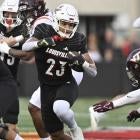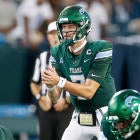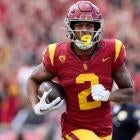If you don't ask for something, you can't get it. This is a philosophy agents live by during free agency. It must also be balanced by the risk of pricing a client out of the market.
Agents and NFL teams have already gotten a sense of the 2018 free agent market. Meetings between agents of impending free agents and teams routinely occur at the recently concluded NFL Combine, although these types of discussions are prohibited by NFL rules. Teams are rarely penalized for tampering with players from other teams when those players are scheduled to become free agents.
The 2018 salary cap came in at $177.2 million, which is $10.2 million higher than last year. The 6.11 percent rise in the cap is the lowest increase since going up 1.99 percent in 2013.
Overall, this year's free agent class isn't particularly strong. Nonetheless, because NFL teams have over $1 billion in salary cap space at their disposal, a robust market is expected during the first wave of free agency, which typically is over after the initial days of the signing period.
It was my responsibility while working on the agent side to create target or asking prices for the firm's clients headed toward free agency regardless of whether I was the lead agent. Along those lines, I have set target prices with total contract value, overall guarantees, amount fully guaranteed at signing and first three years compensation (when applicable) for 15 intriguing players becoming unrestricted free agents or given a franchise/transition designation.
Players don't necessarily sign for their target prices because free agency is a fluid process where adaptations must be made to changing market conditions. Some players are disappointed in free agency's outcome because their market never develops for a variety of reasons (age, unrealistic contract demands, supply at playing position, etc.).
The exclusive negotiating rights teams have had with their impending free agents ends on March 12. NFL teams are allowed to negotiate with the agents of prospective unrestricted free agents during a two-day period ending at 3:59:59 p.m. ET on March 14. Players can't sign deals with new clubs until the 2018 league year and free agency officially begin at 4 p.m. ET. A player's ability to re-sign with his current club is allowed during the period.
We'll cover 15 players in this three-part series. You can find three key quarterbacks below. Part 2 covers six offensive player target contracts, including Le'Veon Bell and Allen Robinson. Part 3 looks at target contracts for key defenders, including Demarcus Lawrence and Sheldon Richardson.
Remember: The target or asking prices for these players may be on the high side and aren't necessarily what their actual deals will be.
QB Kirk Cousins
- Target contract package: five years, $150 million
- Overall guarantees: $100 million
- Fully guaranteed at signing: $70 million
- First three years: $100 million
Good, healthy quarterbacks in their prime, like Cousins, almost never hit the open market. Most teams give quality quarterbacks contract extensions before or during their contract year. The impending trade by the Redskins for Chiefs quarterback Alex Smith, which can't be completed until the 2018 league year starts on March 14, ensures Cousins' availability.
Cousins has been one of the NFL's most productive quarterbacks by conventional statistics since becoming a full-time starter when the 2015 season began. In those three seasons, Cousins has averaged nearly 4,400 passing yards, 27 touchdowns and 12 interceptions while completing 67 percent of his passes for a 97.5 passer rating. His completion percentage and passer rating rank third and sixth, respectively, in the NFL over the last three years. The Redskins had a 24-23-1 record with Cousins under center.
The five-year, $137.5 million contract the 49ers recently gave to the largely unproven Jimmy Garoppolo, making him the NFL's highest-paid player with a $27.5 million per year average salary, raises the bar for established highly effective passers. Lions quarterback Matthew Stafford, who signed a five-year extension averaging a then-record $27 million per year last preseason, remains the NFL standard bearer in overall contract guarantees ($92M), money fully guaranteed at signing ($60.5M), signing bonus ($50M) and three-year cash flow ($87M).
The Jets are reportedly willing to do "whatever it takes" to sign Cousins. The Broncos, Cardinals and Vikings have also reportedly expressed interest in Cousins. Reports about the Vikings being prepared to offer Cousins a fully guaranteed three-year, $91 million contract have surfaced. A $30,333,333 average per year is much more plausible than that same amount fully guaranteed. $91 million would represent slightly more than a 50 percent increase over the established benchmark of Stafford's $60.5 million.
Most lucrative quarterback contracts are at least four years in length. A three-year contract could be most appealing to Cousins, 29, because he could take advantage of changing market conditions sooner than with the more conventional quarterback deal at age 32 in 2021 when a new Collective Bargaining Agreement (CBA) will need to be negotiated. He would be in line for an extension at age 31 in 2020 this way if he is living up to his contract.
QB Drew Brees
- Target contract package: three years, $85 million (with two voidable years for cap purposes)
- Overall guarantees: $60 million
- Fully guaranteed at signing: $45 million
It's a foregone conclusion that Brees will be returning to the Saints next season. Brees, who turned 39 in January, reiterated his desire to finish his career in New Orleans after a stunning loss to the Vikings in the divisional playoffs thanks to a 61-yard walk-off touchdown pass.
The one-year, $24.25 million extension Brees signed in 2016 was structured with 2018 through 2020 contract years that automatically void at 4 p.m. ET on March 14, the last day of the 2017 league year. The inclusion of the three fake years permitted the Saints to prorate Brees' $30 million signing bonus over five years for salary cap purposes instead of just two years.
The Saints should have more of a sense of urgency for a new contract than Brees because of the voidable years. If these dummy years void, the Saints will have an $18 million cap charge during the 2018 league year relating to Brees' signing bonus regardless of what happens afterwards.
It may make sense for Brees and the Saints to do a shorter-term deal since Father Time is undefeated. At a minimum, 2018 and 2019 could be converted into real contract years where the voiding is delayed until the last day of the 2019 league year in March 2020. Additional voiding dummy years may be included so a signing bonus could be stretched out over a longer period of time like in Brees' current contract.
The Saints shouldn't be overly concerned about committing to a second year when Brees is 40 because he has yet to show many signs of slowing down. Although it's no longer necessary for the Saints to rely on Brees's passing for success after developing one of the NFL's most potent rushing attacks, he can still win games with his arm when necessary. Despite throwing for fewer yards (4,334) and touchdowns (23) than in any season since joining the Saints in 2006, Brees set an NFL record by completing 72 percent of his passes this season and was second in the league with a 103.9 passer rating.
Garoppolo's $27.5 million average per year and $48.7 million fully guaranteed at signing could be relevant data points unless Brees is willing to give the Saints a hometown discount for the first time. Should Brees cut the Saints a financial break, the $22 million, $21 million and $20.75 million salaries in his fake 2018, 2019 and 2020 contract years could serve as a guide for a new deal.
QB AJ McCarron
- Target contract package: three years, $50 million (worth up to $60 million with escalators/incentives)
- Overall guarantees: $34 million
- Fully guaranteed at signing: $26 million
McCarron is hitting the open the market because he won the grievance he filed against the Bengals over his free agency status. His last extensive game action came when he took over at quarterback down the stretch of the 2015 season after a broken thumb sidelined Andy Dalton. In seven games (three starts), he connected on 79 of 119 passes (66.4 completion percentage) for 854 yards with six touchdowns and two interceptions, which was good for a 97.1 passer rating. McCarron would have a playoff win to his name but for ill-timed defensive penalties late in a wild-card game loss to the Steelers. He has only taken 28 offensive snaps and thrown 14 passes, all in 2017, since then.
Botched paper prevented the Browns from acquiring McCarron at last season's trading deadline. Browns head coach Hue Jackson's familiarity with McCarron drove the team's interest in him; Jackson was the Bengals' offensive coordinator in 2014 and 2015. It may make sense for the Browns to make another run at McCarron even though a quarterback is likely to be taken with either the first or fourth overall pick in the 2018 NFL Draft.
Jaguars quarterback Blake Bortles's two-year, $34.497 million extension (worth up to another $12.5 million through salary escalators and incentives) with $26.5 million fully guaranteed may serve as a limit for McCarron's compensation. McCarron could benefit from NFL teams' willingness to throw logic out the window with unproven commodities in the ever-elusive search for a competent quarterback, when Mike Glennon and Brock Osweiler ought to be cautionary tales.





















